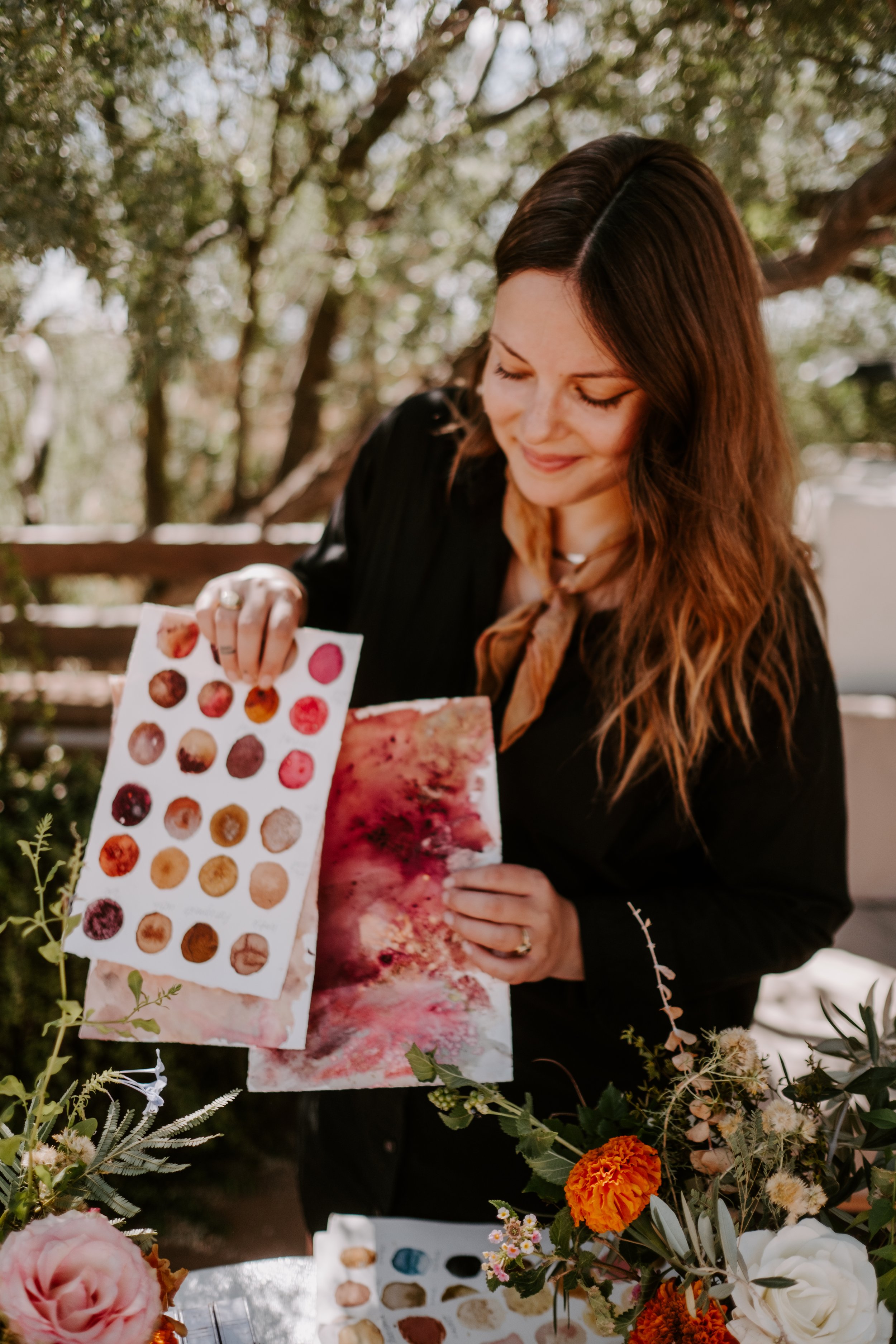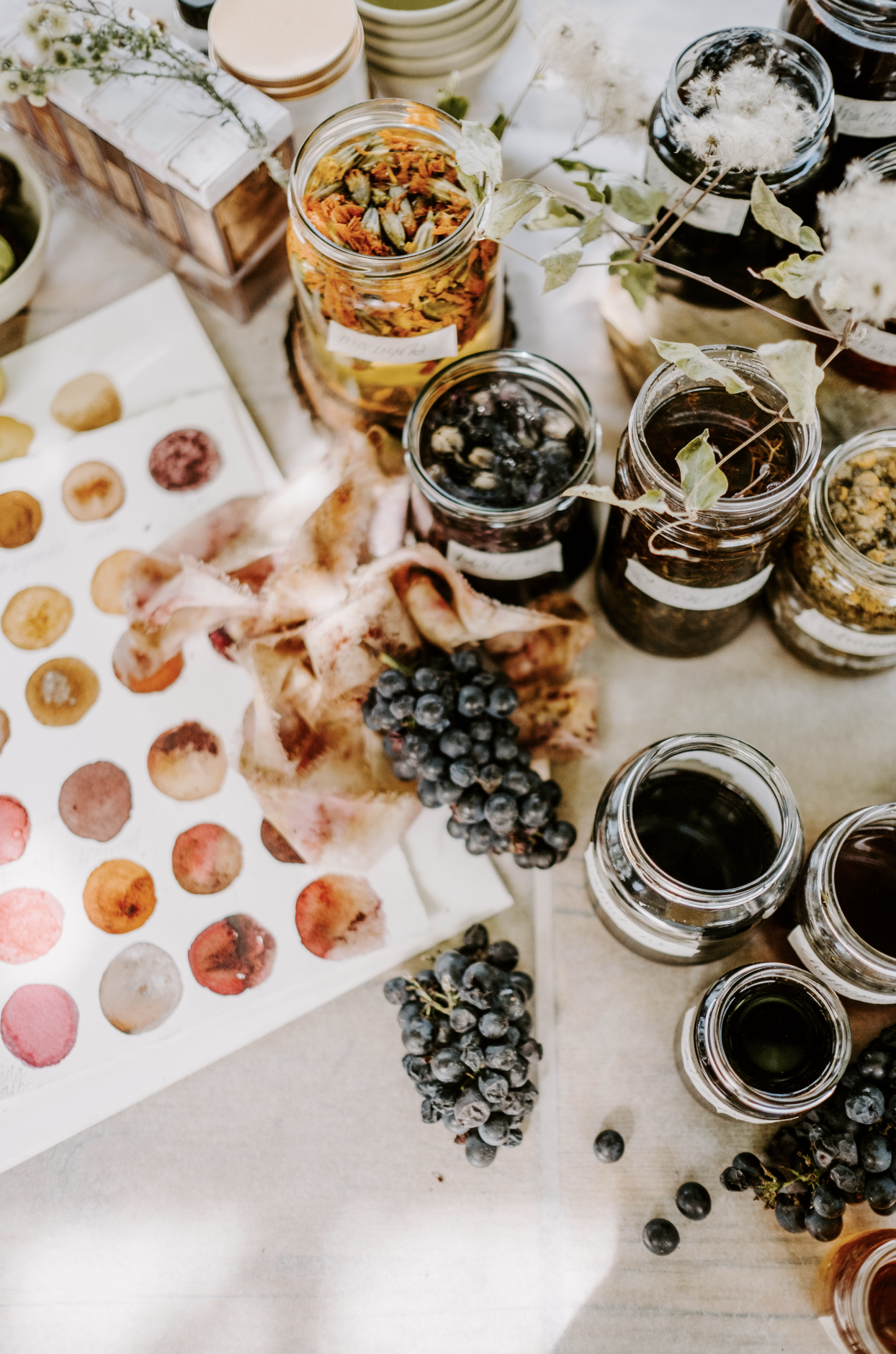
The Natural Artist
Resource Guide
I’m thrilled to share this guide with you—a curated collection of sustainable, eco-friendly materials I’ve come to rely on in my own studio. These materials go beyond just creating art; they offer a way to connect more deeply with nature, prioritizing not only your health but also the well-being of our planet. Using safe, non-toxic, earth-conscious supplies allows you to create freely and responsibly. Every item in this guide has been thoughtfully chosen, tested, and trusted in my creative practice—I stand firmly behind the quality and the inspiration they bring to the art-making journey.
A few things to keep in mind as you explore the world of natural inks:
-
✺
Embrace the Beauty of Living Color
Think of natural inks as “living color”—these hues can shift and transform depending on light exposure. Embrace these changes; there’s a unique beauty in the evolution of each color as it ages.
-
✺
Dedicated Tools for Safe Art-Making
Dedicate your tools to dye and ink making only, avoiding their use with food. Thrifting is a fantastic, sustainable way to find your tools, adding charm and history to your process.
-
✺
Safety First: Ventilation and Protection
Ventilation is essential. Some pigments and pH shifters release particles that are best handled with a mask. Protecting your lungs is as important as your art, so a well-ventilated space is key.
-
✺
Explore Both Tradition and Experimentation
There are tried-and-true materials like plants, roots, and mushrooms that have stood the test of time for creating lasting colors. But remember, if you’re looking to experiment, the natural world is full of possibilities for unique colors.
-
✺
Preserve Materials for Future Creativity
A freezer or dehydrator can help maintain the color of your dye materials, allowing you to revisit your foraged finds whenever inspiration strikes
-
✺
Let Curiosity Be Your Guide
Release control and let curiosity lead. The magic of natural inks lies in their unpredictability. Let go, experiment, and remember that this is living color—embrace its wonder.
✺
Let’s explore my favorite things
Inks and Dyes
Creating colors from nature connects us to an art form as old as time, rooted in the traditions of textile dyeing. Both ink-making and dyeing begin with immersing raw materials in water, releasing the pigments that live within. While textile dyeing often seeks bold saturation immediately, making ink is a slower, more intentional process. This process is unique in that the colors are living—and that’s precisely the beauty of them.
Natural color can be found all around us: in the landscapes we live in, in food waste, and through sustainable foraging practices that honor the earth. Allow yourself the freedom to explore with curiosity. This journey is as much about discovery as it is about creation, and there’s permission here to let your creativity guide you.
Below, you’ll find resources to help you source vibrant, eco-friendly materials from suppliers who are committed to sustainable practices. By using naturally derived dyes, extracts, and raw materials, you’re inviting nature’s beauty and resilience into your art—crafting colors that feel as alive as the places they come from.
PLACES TO SOURCE RAW NATURAL MATERIALS, EXTRACTS, DYES, THICKENERS, MODIFIERS, MORDANTS, TANNINS + FABRICS:
Natural Earth Pigments
Woman-owned and eco-friendly, Natural Earth Paint has been my go-to since the start of my nature-based journey. Known for innovation, they offer non-toxic kits for oil and watercolor artists, vegan gesso, safe natural face paint, Eco-Solve solvent, natural varnish, and, recently, plant-based acrylics. With sustainability at their core, they continue to redefine what eco-friendly art supplies can be.
ADDITIONAL NATURAL PIGMENT COMPANIES I LOVE AND SUPPORT:

all things nature.
✺
Tools and Resources
Tools and Safety
Making natural inks is like stepping into an art kitchen, where each tool has its role, and safety takes center stage. Many of the tools you’ll need can be thrifted or repurposed, adding an element of sustainability to your creative process. The beauty of working with natural colors is that it doesn’t require fancy equipment—just a few essentials, and maybe some curiosity, to get started.
Safety First
In any ink-making setup, keeping your materials separate from everyday kitchenware is key. Using second-hand or retired items you no longer use for cooking is a great way to ensure plant residue doesn’t accidentally find its way into your meals. Ventilation is equally important, as some plant extractions release natural compounds that may require working in a well-aired room, by an open window, or even outdoors. Always confirm the identification and properties of any plants you’re using, and remember that a clean, sterile environment prevents bacteria from finding its way into your inks.
LINKS TO ALL RECOMMENDED TOOLS AND SUPPLIES
Material Preparation
Granite or Porcelain Mortar and Pestle – For grinding dry or soft materials before extraction.
Digital Kitchen Scale – To measure your materials accurately.
Extraction Process
Stainless Steel Pots and Pans – Use these for boiling and simmering plant materials to release pigments.
Instant Read Thermometer – Check temperatures to ensure you’re not overheating.
Wooden Spoon Set – Stir as needed to help release color from the materials.
Wire Masher – Mash the materials during simmering to encourage more color release.
Stainless Steel Tongs – For safely handling any hot items.
Filtering & Refining
Mesh Strainers – Filter out larger plant pieces.
Cheesecloth – For a second filtering to remove finer particles.
Unbleached Coffee Filters – Use for fine filtration or making Lake Pigment.
Stainless Steel Funnels – To pour filtered ink into containers without spills.
Storage
2oz Glass Bottles – Store small batches of ink for easy use.
Wide Mouth Mason Jars – For larger quantities of ink.
Journaling, Recipe Developing + Extras
Notebook – For jotting down ideas, recipes, or notes about the plants you’re using.
Protective Gloves – Keep hands safe while handling more sensitive plants/modifiers.
pH Test Strips – Check the acidity of your ink to ensure stability.
Garden Markers – Label each bottle with the ink type and date.
Washi Masking Tapes – Use tape to date and label your inks.
Waterproof Notebook – Perfect for outdoor notes, especially if you’re foraging.
Portable Induction Cooktop – For controlled heating in different locations, especially useful if you don’t have easy access to a stove.
With these tools and safety practices in place, you’re set to explore the colors nature has to offer! Let curiosity be your guide as you experiment with pigments, creating inks that carry the essence of the natural world.
FULL LIST OF LINKS RIGHT HERE!

forever learning from nature.
✺
All The Beautiful Art Books
Foundational Books for Natural Dye and Ink Making
These books are some of my absolute favorites, each offering a strong foundation in the art of natural dyes and ink-making. They’re filled with knowledge, techniques, and inspiration, making them perfect companions as you start experimenting with creating colors from nature. Whether you’re looking to understand the science behind plant pigments or want practical recipes and methods, these resources will guide you every step of the way.

staying inpired.
✺
Inspiring Studio
Curating an Inspiring Studio Space
Whether you have a designated studio or simply a cozy nook by the kitchen, creating a space that feels inspiring and beautiful can fuel your creativity. My own studio doubles as my baby’s nursery, so maintaining a space that’s both eco-friendly and filled with good energy is essential. A few intentional touches—like my favorite lamp for recording, handmade ceramics, or lighting a candle—bring a sense of romance to the space and help set the mood for creating.
Whatever your setup, bringing small elements that make you feel connected, inspired, and at ease can make all the difference. Your studio doesn’t have to be elaborate; sometimes, it’s the simplest things that create the most magic.
Canvas Lamp - My most essential studio tool. It makes recording beautifully lit videos of my process effortless. Use code “TANYA10” for a discount!
Handmade Ceramics and Palettes – Among my favorite things to collect (right up there with rocks and plants), ceramic palettes have become such a special part of my creative process. Here are a few of my favorites:
Krista Coons Studio - Woman-owned and truly unique, Krista creates art pieces that are as beautiful as they are functional. I’ve built a collection of her ceramic brushes, painting palettes, ornaments, and brush dishes, and I can’t wait to add more.
Sugarhouse Ceramics - An incredibly talented couple from Canada! I love their travel ceramic palettes, handmade brushes, ornaments, and unique art supplies, each piece a special addition to my studio.
Natural Earth Paint Brushes - ou’ve seen me gush over this company, but their newest handmade natural brushes have been my go-to for painting. I also adore their and travel wooden watercolor palette, glass palette and glass muller.
Do It For The Process Studio Candle by Emily Jeffords - My favorite scent to get me ready to create. This candle has become a cherished part of my studio practice. Pair it with Emily’s Affirmation Deck for extra inspiration to dive into your creative flow!
With Deep Gratitude
and Inspiration
Thank you for joining me on this journey into the beautiful world of natural materials. I hope this guide fills you with inspiration and excitement to explore, experiment, and create with nature. Working with earth-derived colors and sustainable practices has been a true passion for me, and it’s a joy to share that passion and process with you. Remember, there’s no “right” way to create—let your curiosity lead you, and know that every color you uncover is part of a larger, beautiful connection with the world around us. If you have any questions or need guidance, don’t hesitate to reach out—I’m here to support you on your creative journey.
With Love from Alaska,
Tanya













